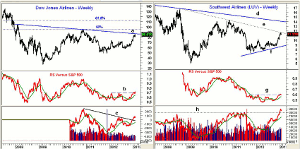With all the problems of Boeing’s 787 Dreamliner all over the news in recent weeks, MoneyShow’s Tom Aspray takes a technical look at an often-troubled sector to see if there are opportunities.
The daily ranges picked up a bit on Thursday, but again, the buyers seemed to step in as most of the major averages did close well above the day’s lows. The S&P futures hit a low of 1494.50 before lunch and then closed the day at 1505.
The housing sector was hit the hardest as Philadelphia Housing Sector Index was down 1.2%. On the plus side were the Dow Jones Transportation and Utility Indices, which were both up 0.25%.
In the transportation sector many are speculating that American Airlines (AAMRQ) and US Airways Group (LCC) will merge, maybe as early as next week. This would create the largest world airline as it would kick United Continental Holdings (UAL) out of first place.
The airline companies always seem to be at the mercy of the fickle consumer and oil prices, so as a sector, they seem to get less attention from analysts and the public. In looking at the performance of this sector since the March 2009 lows, I regret not keeping a closer eye on this group.
Since the bear market lows the Dow Jones Airlines Index (DJUSAR) is up a whopping 221% versus a 125% gain in the Spyder Trust (SPY). Some may wonder if a merger will give the sector a further boost and whether opportunities still exist, let’s take a look.
Chart Analysis: The weekly chart of the Dow Jones Airlines Index (DJUSAR) shows that it has reached trend line resistance, line a, that goes back to early 2008.
- In January of 2007, the Index made its all-time high of 164.41.
- The 50% Fibonacci retracement resistance stands at 95, which is 11.7% above current levels.
- The major 61.8% retracement resistance stands at 112.
- The relative performance has just moved above the resistance from early 2012, line b.
- A strong close above this level will confirm that the sector is starting a new period of outperforming the S&P 500.
- The weekly OBV moved above its WMA in early December and then last month moved through the downtrend, line c.
- The chart has first support at 80 with more important at 72-74.
Southwest Airlines (LUV) finished second behind JetBlue Airways (JBLU) in a recent ranking of low-cost airlines. The stock hit its all-time high price of $23.32 in 2001.
- The weekly chart shows the sharp 44% drop from the late 2010 high to the 2011 low of $8.04.
- The uptrend from these lows was gradual until LUV broke out in early December.
- The downtrend from the 2008 and 2010 highs, line e, has now been reached.
- There is further resistance in the $12.60-$13.20 area as prices have been testing the weekly starc+ bands for the past month.
- The longer-term downtrend, line d, is just above $14 and it connects the 2006 and 2008 highs.
- The weekly relative performance overcame its resistance, line g, in the middle of January and is well above its rising WMA
- The OBV is acting much stronger as it has moved above the resistance from 2010-2011, line h, in the past few weeks.
- The recent pullback in LUV held well above the monthly pivot at $11.06, which is first support with further in the $10.50-$10.75 area.
NEXT PAGE: Highest High-Flyer of All |pagebreak|
Alaska Air Group (ALK) has been the top-rated large carried for the past five years in a row, which helps to explain the very bullish monthly chart.
- The major breakout, line 1, occurred at the end of March 2010 as the resistance from 1998 was overcome with the close at $20.61.
- ALK is up 130% since the breakout, and it closed at the monthly starc+ band in January and has been quite close to it for the past three months.
- The monthly OBV moved above its WMA one month before prices and broke out and also overcame its downtrend, line d.
- The weekly OBV (not shown) completed its bottom in August 2009, further supporting the value of multiple time frame OBV analysis.
- The monthly OBV has stayed well above its rising WMA for the past 34 months and made another new high in January.
- This again confirms the long-term bullish trend with first monthly support at $42.
- There is more important support at $39.76, which was the early 2012 high.
What it Means: Though the monthly and weekly technical action of the airline sector and many of the airlines do look impressive, finding a good entry point for most is a challenge.
Some of the large carriers like US Airways Group (LCC) and United Continental Holdings (UAL) are just below major resistance where their rallies may fail.
In a final scan of this sector before press time, I noticed that JetBlue Airways (JBLU) had corrected just over 38.2% from its high at $6.42. It has held well above the key support at $5.55. It is a low-priced issue but new longs are recommended. I will post a chart on Twitter.
How to Profit: For JetBlue Airways (JBLU), go 50% long at $5.83 and 50% at $5.74, with a stop at $5.48 (risk of approx. 5.7%).
Editor’s Note: If you’d like to learn more about technical analysis, attend Tom Aspray’s workshop at The Trader’s Expo New York, February 17-19. You can sign up here, it’s free.




















